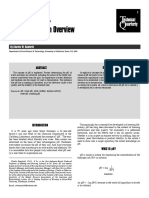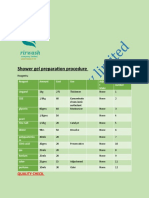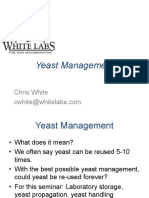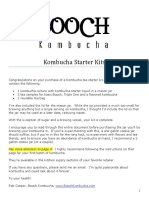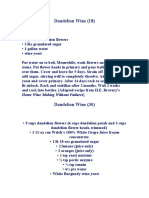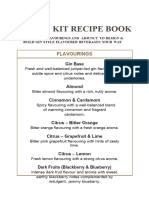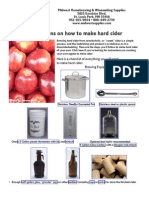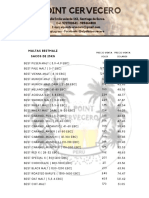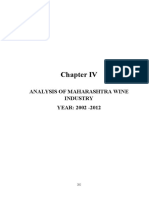0 ratings0% found this document useful (0 votes)
296 viewsGinger Beer: (Using Double Fermentation Based Loosely On La Méthode
Ginger Beer: (Using Double Fermentation Based Loosely On La Méthode
Uploaded by
velivolantThis document provides instructions for making ginger beer using a double fermentation method based on the champagne method. It lists the ingredients needed, which include ginger, lemon juice, champagne yeast, water, and sugar. It describes a first fermentation where the ginger-infused liquid is sealed for 20-24 hours. It then describes pouring off the liquid and doing a second fermentation for 2 days by adding more sugar-infused ginger liquid and sealing it. Optional steps include removing sediment through remuage and disgorgement over several weeks.
Copyright:
© All Rights Reserved
Available Formats
Download as DOCX, PDF, TXT or read online from Scribd
Ginger Beer: (Using Double Fermentation Based Loosely On La Méthode
Ginger Beer: (Using Double Fermentation Based Loosely On La Méthode
Uploaded by
velivolant0 ratings0% found this document useful (0 votes)
296 views2 pagesThis document provides instructions for making ginger beer using a double fermentation method based on the champagne method. It lists the ingredients needed, which include ginger, lemon juice, champagne yeast, water, and sugar. It describes a first fermentation where the ginger-infused liquid is sealed for 20-24 hours. It then describes pouring off the liquid and doing a second fermentation for 2 days by adding more sugar-infused ginger liquid and sealing it. Optional steps include removing sediment through remuage and disgorgement over several weeks.
Original Description:
probably over doing it
Original Title
Ginger Beer Recipe
Copyright
© © All Rights Reserved
Available Formats
DOCX, PDF, TXT or read online from Scribd
Share this document
Did you find this document useful?
Is this content inappropriate?
This document provides instructions for making ginger beer using a double fermentation method based on the champagne method. It lists the ingredients needed, which include ginger, lemon juice, champagne yeast, water, and sugar. It describes a first fermentation where the ginger-infused liquid is sealed for 20-24 hours. It then describes pouring off the liquid and doing a second fermentation for 2 days by adding more sugar-infused ginger liquid and sealing it. Optional steps include removing sediment through remuage and disgorgement over several weeks.
Copyright:
© All Rights Reserved
Available Formats
Download as DOCX, PDF, TXT or read online from Scribd
Download as docx, pdf, or txt
0 ratings0% found this document useful (0 votes)
296 views2 pagesGinger Beer: (Using Double Fermentation Based Loosely On La Méthode
Ginger Beer: (Using Double Fermentation Based Loosely On La Méthode
Uploaded by
velivolantThis document provides instructions for making ginger beer using a double fermentation method based on the champagne method. It lists the ingredients needed, which include ginger, lemon juice, champagne yeast, water, and sugar. It describes a first fermentation where the ginger-infused liquid is sealed for 20-24 hours. It then describes pouring off the liquid and doing a second fermentation for 2 days by adding more sugar-infused ginger liquid and sealing it. Optional steps include removing sediment through remuage and disgorgement over several weeks.
Copyright:
© All Rights Reserved
Available Formats
Download as DOCX, PDF, TXT or read online from Scribd
Download as docx, pdf, or txt
You are on page 1of 2
ginger beer
(using double fermentation
based loosely on la mthode
champenoise)
I messed around a few times to get the proportions and timing to what I
thought was pretty ideal, but obviously preferred amounts ginger, carbonation,
etc. vary from person to person. The easiest way to adjust while youre going is
to start off with less water and sugar than you think and add if the flavour is
too strong or carbonation not strong enough, respectively. And dont use bread
yeast; this actually matters because champagne yeast (as well as other brewers
yeasts) is bred for flavour and alcohol tolerance. I used the Pasteur Champagne
type which ferments a bit quicker and yields alcohol content 13-17%.
YOU WILL NEED:
/ a fist full of ginger root (or like 1/3 the size of a big banana) peeled
/ the juice from a wedge of lemon
/ a packet of champagne yeast (you wont need the whole packet)
/ about half a gallon of water
/ about half a cup of sugar but this is a little give and take feed your yeast!
(ideally they say rock sugar but I used regular granulated stuff and it was fine)
/ a tight sealing jar or bottle large enough to hold everything
THE FIRST FERMENTATION:
/ With the peeled ginger root you can either throw that into a blender/food
processor to mush up or just grate right into a small pot. The point is to infuse
the ginger flavour so you want all the juice in there too.
/ Toss into that pot 2 cups of water, all the lemon juice, and 1/4 cup of sugar
and bring to a simmer while mixing so sugar dissolves. Meanwhile, fill your
container with 6-7 cups of water (room temp or cold).
/ Once everythings all nicely dissolved and still hot, add 1/4 tsp (I used a little
less) yeast and stir to dissolve. Then pour the whole mixture, including ginger
bits into the bottle. Stir to distribute, and you can either allow the carbon
dioxide to escape (as per la mthode champenoise) or seal that sucker because the
bubbles are great and youre not making fancy champagne. Champagne yeast
has a medium to low flocculation, meaning it takes longer for the yeast to
cluster and settle out of liquid. Leave for 20-24 hours.
THE SECOND FERMENTATION:
/ Pour out everything into a bowl large enough and, using a strainer to catch
the chunks, pour liquid back into the bottle or jar, saving 2 cups. Bring those 2
cups, the ginger clumps, and an additional 1/4 cup of sugar to simmer as
before. There will already be some carbonation so you will see bubbles before
boiling; these are the death throes of your yeast babies so shed a quick tear, but
not into the pot.
/ Once again, dissolve 1/4 tsp of yeast into sugar mixture and stir this back
into the jar, then seal that sucker up. Second fermentation for good champagne
generally takes between 4-8 weeks, with ageing on lees taking at least 2 years
(non-vintage) or 6 years (vintage), but that kind of patience is mythic so just
wait 2 days.
REMUAGE / DISGORGEMENT (OPTIONAL):
/ This refers to the removal of the lees (the mixture of dead yeast and other
solid stuff at the bottom), a process that takes 2 months by hand or about a
week with new special machines. Just as some champagnes are left cloudy, you
can leave your ginger beer cloudy too just strain out the ginger chunks before
drinking. This is easier and the way a lot of store bought ginger beer comes
sold (e.g. maine root).
/ If you so desire the removal of all the bits of yeast, transfer strained liquid to
bottle or container with narrow neck and store at 45 degree angle with neck
downwards. Then slowly (day by day so the yeast stays settled without losing
too much liquid) rotate to eventually lower neck to vertically down. Quick-
freeze contents of neck in cold brine. Once the cap is removed, the carbon
dioxide should help push out the yeast plug.
You might also like
- Rice BeerDocument8 pagesRice BeerPied7PiperNo ratings yet
- Ginger Beer RecipesDocument2 pagesGinger Beer RecipesKian Hwang100% (2)
- What Are The Functions of Sodium Metabisulfite?: Chemical PropertiesDocument4 pagesWhat Are The Functions of Sodium Metabisulfite?: Chemical PropertiesSuria Cahaya100% (1)
- Make Yeast StarterDocument2 pagesMake Yeast StarterAlexandraNo ratings yet
- Buccaneer Bobs Silver Gold and Black Rum RecipeDocument6 pagesBuccaneer Bobs Silver Gold and Black Rum RecipeJeremy Daniel MeadowsNo ratings yet
- Brooklyn Brew Shop - Everyday IPA InstructionsDocument3 pagesBrooklyn Brew Shop - Everyday IPA Instructionstecleador10% (1)
- Ginger Beer and Ale RecipeDocument2 pagesGinger Beer and Ale RecipeLenSmithNo ratings yet
- Homemade Kombucha - The Simple Guide To Kickass Kombucha PDFDocument1 pageHomemade Kombucha - The Simple Guide To Kickass Kombucha PDFfatihy73No ratings yet
- Ice Creams, Water Ices, Frozen Puddings Together with Refreshments for all Social AffairsFrom EverandIce Creams, Water Ices, Frozen Puddings Together with Refreshments for all Social AffairsNo ratings yet
- BeerSmith Home Brewing GuideDocument3 pagesBeerSmith Home Brewing GuideBrad SmithNo ratings yet
- Ginger BeerDocument85 pagesGinger BeerAron Farkas100% (1)
- Mangrove Jack's BREWER'S YEASTS FOR CRAFT BREWINGDocument13 pagesMangrove Jack's BREWER'S YEASTS FOR CRAFT BREWINGLois99No ratings yet
- Robo Brew 35 L InstructionsDocument5 pagesRobo Brew 35 L Instructionssteve_milenNo ratings yet
- BAMFORTH, PH in BrewingDocument9 pagesBAMFORTH, PH in BrewingVohinh NgoNo ratings yet
- Enzymes in BrewingDocument8 pagesEnzymes in BrewingAlexandru TarțianNo ratings yet
- 01 - Beer Stabilisation Part 1 PDFDocument2 pages01 - Beer Stabilisation Part 1 PDFNelcy LatorreNo ratings yet
- Advanced Bottle ConditioningDocument3 pagesAdvanced Bottle ConditioningRade StevanovicNo ratings yet
- Fermentedtreasures Ginger Beer BrewingDocument3 pagesFermentedtreasures Ginger Beer BrewingguennikNo ratings yet
- Beer Brewing For BeginnersDocument5 pagesBeer Brewing For BeginnerspauloadrianoNo ratings yet
- The Theory of MashingDocument6 pagesThe Theory of MashingVohinh NgoNo ratings yet
- Beer Bread 73440Document3 pagesBeer Bread 73440Anqia van Loggerenberg100% (1)
- 2012 01 20BrewingExtremeBeersDocument59 pages2012 01 20BrewingExtremeBeersMarjoriCrispimNo ratings yet
- Beer TechnologyDocument53 pagesBeer TechnologyLeon BobNo ratings yet
- Jeffrey Morgenthaler Barrel Aged CocktailsDocument12 pagesJeffrey Morgenthaler Barrel Aged CocktailsMartin Parzer100% (1)
- CiderReview HR 34 2007Document53 pagesCiderReview HR 34 2007Nerv RulzNo ratings yet
- Dry Hopping A Study of Various ParametersDocument5 pagesDry Hopping A Study of Various Parametersfir3f0xNo ratings yet
- Cat's Meow Home Brewing 09 Belgian German ScottishDocument40 pagesCat's Meow Home Brewing 09 Belgian German Scottishnawick100% (1)
- Enzyme InformationDocument7 pagesEnzyme InformationLong ThuậnNo ratings yet
- Beer FoamDocument25 pagesBeer FoamHarsha TheegalaNo ratings yet
- Beer Essentials - HopsDocument36 pagesBeer Essentials - HopsPedro Mayer DentzienNo ratings yet
- Stone Pale Ale and Garlic Stir-Fried Brussels Sprouts From The Craft of Stone Brewing Co.Document6 pagesStone Pale Ale and Garlic Stir-Fried Brussels Sprouts From The Craft of Stone Brewing Co.The Recipe ClubNo ratings yet
- Preparation Recipe For Detergents .RirwashDocument4 pagesPreparation Recipe For Detergents .Rirwashrirwaye brianNo ratings yet
- Distillation of GinDocument6 pagesDistillation of GinJan Chester ChanNo ratings yet
- Cider Making Made EasyDocument6 pagesCider Making Made Easybartolomej7No ratings yet
- Maza Gomez ThesisDocument154 pagesMaza Gomez ThesisSulaiman Salihu100% (1)
- BeerDocument34 pagesBeerRojan PradhanNo ratings yet
- Bottle FermentedDocument50 pagesBottle FermentedJonian KokonaNo ratings yet
- Mini Jet Wine Filter InstructionsDocument2 pagesMini Jet Wine Filter InstructionsGerry CouturierNo ratings yet
- Chen 382 FinalDocument9 pagesChen 382 Finalapi-240464495No ratings yet
- Homebre1w Chef - Westmalle Tripel Clone RecipeDocument2 pagesHomebre1w Chef - Westmalle Tripel Clone RecipeMark ConnollyNo ratings yet
- Fruit Based Alcoholic BeveragesDocument18 pagesFruit Based Alcoholic BeveragesmilanNo ratings yet
- How To Brew Beer at HomeDocument5 pagesHow To Brew Beer at Homelucas.siqueiraNo ratings yet
- Chapter 4 - Microbiology and BiotechnologyDocument64 pagesChapter 4 - Microbiology and BiotechnologyLazarus Kadett NdivayeleNo ratings yet
- 2014 MBAA Chris White Yeast ManagementDocument30 pages2014 MBAA Chris White Yeast ManagementAdrián LampazziNo ratings yet
- Kombucha Starter Kit InstructionsDocument13 pagesKombucha Starter Kit InstructionswaltersddNo ratings yet
- The Italian Kitchen - Pizza Dough and Recipe EBookDocument12 pagesThe Italian Kitchen - Pizza Dough and Recipe EBookJoe VuNo ratings yet
- SAKE Home BrewDocument22 pagesSAKE Home Brewcris kingNo ratings yet
- Dandelion Wine (18) : Home Wine Making Without Failures)Document3 pagesDandelion Wine (18) : Home Wine Making Without Failures)Erin WatsonNo ratings yet
- BrewingDocument35 pagesBrewingVincent JingaNo ratings yet
- Craft Gin Kit Receta BookDocument11 pagesCraft Gin Kit Receta BookPachi SánchezNo ratings yet
- Beer BreadDocument2 pagesBeer BreadLouise AlstonNo ratings yet
- Instructions On How To Make Hard CiderDocument3 pagesInstructions On How To Make Hard CiderkarnizsdjuroNo ratings yet
- Manual On The Production of Traditional MozzarellaDocument56 pagesManual On The Production of Traditional MozzarellaSalman LabiadhNo ratings yet
- Morebeer! Beer Making Instructions: Morebeer! Personal Brewery Starter SystemDocument2 pagesMorebeer! Beer Making Instructions: Morebeer! Personal Brewery Starter SystemTeddy Riaño AlarconNo ratings yet
- Kombucha Recipes From Kombucha DrinkersDocument18 pagesKombucha Recipes From Kombucha DrinkersharleyxxNo ratings yet
- Enological Studies - I. Experiments in Cider Making Applicable to Farm Conditions II. Notes on the Use of Pure Yeasts in Wine MakingFrom EverandEnological Studies - I. Experiments in Cider Making Applicable to Farm Conditions II. Notes on the Use of Pure Yeasts in Wine MakingNo ratings yet
- Difference Between Antibacterial and AntibioticDocument5 pagesDifference Between Antibacterial and Antibiotickhoirul_muhtar31No ratings yet
- The Brewer's Apprentice+OCRDocument193 pagesThe Brewer's Apprentice+OCRRena Roca100% (10)
- Antibiotic eDocument55 pagesAntibiotic eSilvia IoanaNo ratings yet
- Laboratory Exercise 1Document3 pagesLaboratory Exercise 1RICA MAE LUMICTIN100% (1)
- Lallemand Catalogue 2020Document62 pagesLallemand Catalogue 2020zmajeed2016No ratings yet
- Beer ShopDocument30 pagesBeer ShopHarshad AhireNo ratings yet
- YeastDocument2 pagesYeastrenatoNo ratings yet
- Chemistry Project Class 12Document9 pagesChemistry Project Class 12Jay YdvNo ratings yet
- FRL Alcohol Importers Ak To FLDocument326 pagesFRL Alcohol Importers Ak To FLsalesNo ratings yet
- Class 12 Comparitive Study of Rate of Fermentation.Document13 pagesClass 12 Comparitive Study of Rate of Fermentation.shukla duttaNo ratings yet
- Project FileDocument15 pagesProject FileAbhiNo ratings yet
- Beer 101Document26 pagesBeer 101Pushpabandu KarunagalageNo ratings yet
- Douro - DossierDocument17 pagesDouro - DossierRui M. C. PimentaNo ratings yet
- List of Liquor Distributors by StateDocument22 pagesList of Liquor Distributors by Statescott.maison0% (1)
- Week 14 Shires - America - Beer - FoodDocument34 pagesWeek 14 Shires - America - Beer - Foodmichaelburke47No ratings yet
- Wine GlossaryDocument41 pagesWine GlossaryMaria Ana Neves FigueiraNo ratings yet
- 1 Brewing BeerDocument10 pages1 Brewing BeerAggyapal Singh JimmyNo ratings yet
- Question Bank DHMDocument16 pagesQuestion Bank DHMChandan SinghNo ratings yet
- Blonde BimboDocument1 pageBlonde Bimboapi-206426830No ratings yet
- Daftar Obat High AlertDocument1 pageDaftar Obat High AlertirfanabdulNo ratings yet
- There's A Sulfur Smell in My Wine!Document9 pagesThere's A Sulfur Smell in My Wine!Anonymous ePcnZoBENo ratings yet
- Diabetic Drug With Trade NameDocument5 pagesDiabetic Drug With Trade NameNazmul Alam FarukiNo ratings yet
- James Joyce - Edmund WilsonDocument83 pagesJames Joyce - Edmund WilsonelapestosoNo ratings yet
- Belgian Golden Strong AleDocument2 pagesBelgian Golden Strong AlePIPSARNo ratings yet
- Wset L2wines Specification en May2023 Issue2Document29 pagesWset L2wines Specification en May2023 Issue2vish A100% (1)
- Duty Free Price ListDocument268 pagesDuty Free Price ListsghkaranNo ratings yet
- Lista de Precios El Point Cervecero - Insumos PDFDocument7 pagesLista de Precios El Point Cervecero - Insumos PDFTafur ProduccionNo ratings yet
- Project WineDocument122 pagesProject WineCletus PaulNo ratings yet
- Sierra Nevada Pale Ale CloneDocument2 pagesSierra Nevada Pale Ale Cloneantonio alberto gutierrez suarezNo ratings yet
- Beer (Introduction, Types, Productions & Storage)Document12 pagesBeer (Introduction, Types, Productions & Storage)RHTi BDNo ratings yet













